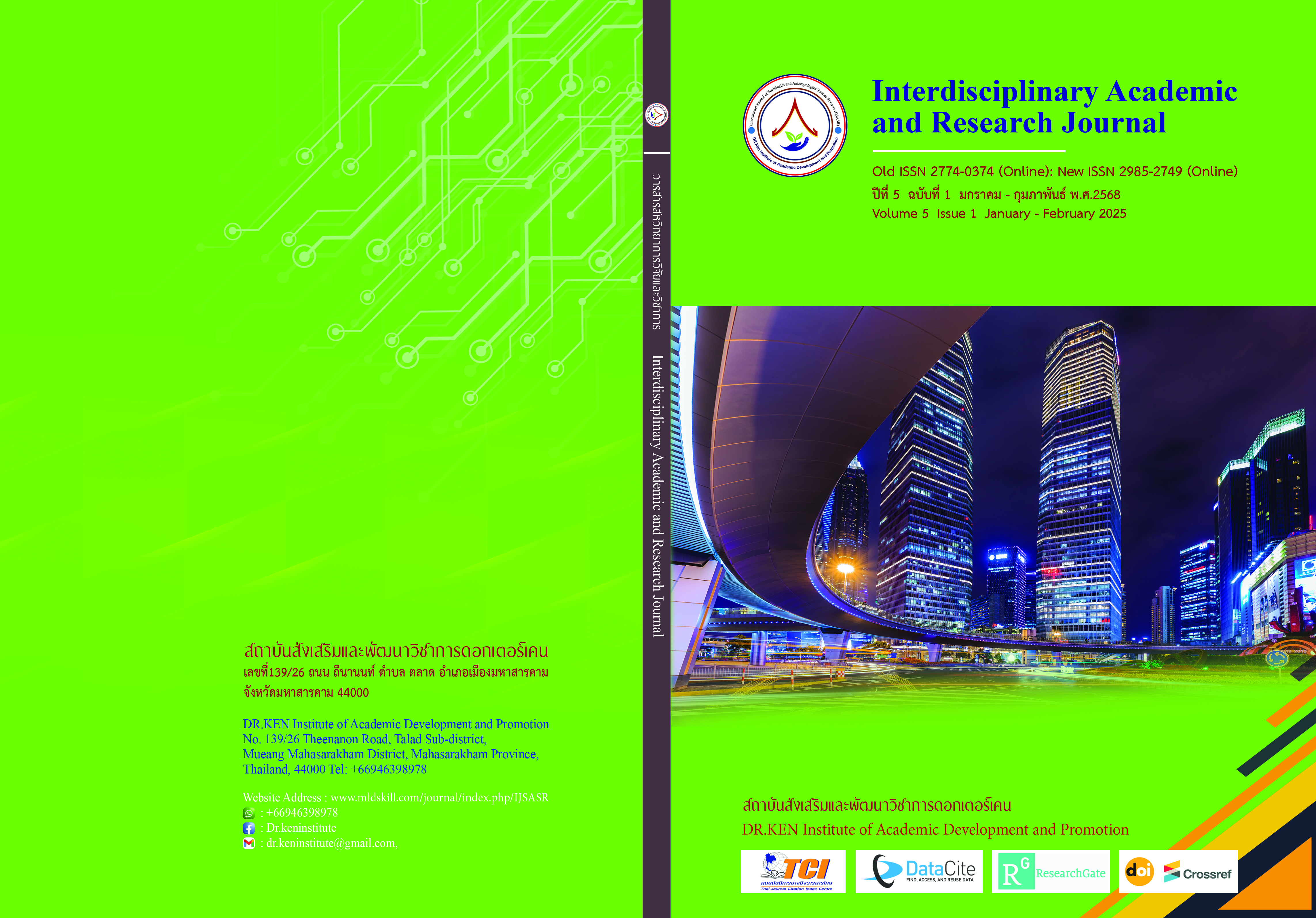Creative Leadership of Subdistrict Headman and Village Headman: A Case Study at Nongki District, Buriram Province
DOI:
https://doi.org/10.60027/iarj.2025.280837Keywords:
Creative leadership, Headman, Village HeadmanAbstract
Background and Aims: Creative leadership is critical for driving innovation and cultivating a culture of adaptability within organizations. It encourages teams to think outside the box, allowing them to solve complex problems while remaining competitive in rapidly changing environments. Thus, this research aimed to 1) study the level of creative leadership of village headmen and sub-district headmen in Nong Ki District, Buriram Province, and 2) study opinions and suggestions on creative leadership of village headmen and sub-district headmen in Nong Ki District, Buriram Province, to be proposed to village headmen and sub-district headmen in 3 aspects: vision, flexibility, and problem-solving.
Methodology: The quantitative research was conducted using 70,483 samples from 382 people in Nong Ki District, Buriram Province. The sample size was determined according to the table of Krejci and Morgan, and the samples were randomly distributed to different villages in proportion using the simple random sampling method. The data collection tool was a questionnaire. Basic statistics were used for data analysis, namely frequency, percentage, mean, and standard deviation.
Results: The research found that the creative leadership of village headmen and sub-district headmen in Nong Ki District, Buriram Province was at a high level overall. When considering each aspect, all aspects were at a high level, ranked from the aspect with the highest average value to the lowest as follows: vision, flexibility, and problem-solving, respectively. The opinions and suggestions with the highest number were that village headmen and sub-district headmen should have a broad vision for their work. In order to develop the village and accept the opinions of the people, set clear development goals, be able to manage the village to develop working methods to achieve the objectives and goals set efficiently, should be able to adapt to changing situations appropriately, adjust and amend work regulations according to changing situations without sticking to the old working methods, should have consideration in finding ways to solve problematic situations, use reason to solve problems without personal bias, listen to the opinions of the people before deciding to solve problems, respectively.
Conclusion: The study concludes that creative leadership by village and sub-district headmen in Nong Ki District is highly effective, with strengths in vision, flexibility, and problem-solving. It emphasizes the importance of having a broad vision, being adaptable, and solving problems objectively in order to drive village development and meet community needs.
References
กรมการปกครอง. (2550). คู่มือปฏิบัติงาน สำหรับกำนัน ผู้ใหญ่บ้าน ปี 2550. พิมพ์ครั้งที่ 7 กรุงเทพฯ : สำนักพิมพ์ : อาสารักษาดินแดน.
กรมการปกครอง. (2559).กฎกระทรวงแบ่งส่วนราชการกรมการปกครอง กระทรวงมหาดไทย พ.ศ. 2559. ประกาศในราชกิจจานุเบกษา เล่ม 133 ตอนที่ 6 ก ลงวันที่ 18 มกราคม 2559.
กรองทิพย์ นาควิเชตร. (2552). ภาวะผู้นำสร้างสรรค์เพื่อการศึกษา. กรุงเทพฯ : สำนักพิมพ์ : ธีรสาส์น พับ ลิชเชอร์จำกัด.
กฤตกร น้ำทิพย์. (2560). ภาวะผู้นำทางวิชาการของผู้บริหารสถานศึกษา กลุ่มสหวิทยาเขตบ้านบึง 1 สังกัดสำนักงานเขตพื้นที่การศึกษาประถมศึกษาชลบุรี เขต 1 (งานนิพนธ์การศึกษามหาบัณฑิต สาขาวิชาการบริหารการศึกษา). ชลบุรี : มหาวิทยาลัยบูรพา.
คติพงษ์ อ่อนไชย, สถิรพร เชาวน์ชัย และ วิทยา จันทร์ศิลา. (2565). แนวทางการพัฒนาภาวะผู้นำเชิงสร้างสรรค์ของผู้บริหารสถานศึกษา ในอาชีวศึกษา จังหวัดพิจิตร สังกัดสำนักงานคณะกรรมการการอาชีวศึกษา. Journal of Modern Learning Development. 7 (2), 65-76.
นนทวรรณ นามะยอม. (2560). ภาวะผู้นำของผู้บริหารสถานศึกษาโรงเรียนขยายโอกาสทางการศึกษา. วิทยานิพนธ์ศึกษาศาสตรมหาบัณฑิต สาขาวิชาการบริหารการศึกษา : มหาวิทยาลัยฟาร์อีสเทอร์น.
นพพล ศุภวิทยาเจริญกุลม. (2560). ภาวะผู้นำของผู้บริหารสถานศึกษา สังกัดสำนักงานเขตพื้นที่การศึกษาประถมศึกษาสกลนคร เขต 1. วิทยานิพนธ์ปริญญาครุศาสตรมหาบัณฑิต สาขาวิชาการบริหารการศึกษา : มหาวิทยาลัยราชภัฏสกลนคร.
บงกชมาศ เอกเอี่ยม. (2557). กํานัน-ผู้ใหญ่บ้าน: บทบาทและภาวะความเป็นผู้นํากับความคาดหวังของประชาชนที่มีต่อผู้นำชุมชนท้องถิ่นในจังหวัดเชียงใหม่. ในการประชุมวิชาการการพัฒนาชนบทที่ยั่งยืน ครั้งที่ 4 ประจำปี 2557, วันที่11-13 มิถุนายน 2557, ณ วิทยาลัยบริหารศาสตร์มหาวิทยาลัยแม่โจ้ อําเภอสันทราย จังหวัดเชียงใหม่.
พจน์ เจริญสันเทียะ, พรหมินทร์ ศรีหมื่นไวย, วิรัลพัชร วงศ์วัฒน์เกษม, วิมาน วรรณคำ และ สมัคร ไวยขุนทด. (2566). ภาวะผู้นำเชิงสร้างสรรค์ของผู้บริหารสถานศึกษา สังกัดสำนักงานเขตพื้นที่การศึกษาประถมศึกษานครราชสีมาเขต 1. วารสารศึกษาศาสตร์ มหาวิทยาลัยทักษิณ. 23 (1),156-163.
ศุภิสรา ธารประเสริฐ. (2563). ประสิทธิผลการปฏิบัติหน้าที่ของกำนัน ผู้ใหญ่บ้านในเขตอำเภอธาตุพนม จังหวัดนครพนม. วิทยานิพนธ์รัฐประศาสนศาสตรมหาบัณฑิต: มหาวิทยาลัยราชภัฏสกลนคร.
สมหวัง อาลัยญาติ. (2551). ความสัมพันธ์ระหว่างภาวะผู้นำของผู้บริหารสถานศึกษากับผลการประกันคุณภาพภายในสถานศึกษา สังกัดสำนักงานเขตพื้นที่การศึกษาพระนครศรีอยุธยา เขต 1 และเขต 2. วิทยานิพนธ์ครุศาสตรมหาบัณฑิต สาขาวิชาการบริหารการศึกษา. มหาวิทยาลัยราชภัฏพระนครศรีอยุธยา.
สัมฤทธิ์ กางเพ็ง. (2557). ภาวะผู้นำแบบโลกาภิวัตน์: แนวคิดและการวิจัย. พิมพ์ครั้งที่ 2. ขอนแก่น : สำนักพิมพ์ : คลังนานาวิทยา.
สำนักงานพัฒนาชุมชนอำเภอหนองกี่ จังหวัดบุรีรัมย์. (2559). ประวัติความเป็นมาและสภาพทั่วไป. Retrieved July 18, 2024, from: https://district.cdd.go.th/nongki/about-us/ประวัติความเป็นมา/ออนไลน์
เสาวนีย์ สมบูรณ์ศิโรรัตน์. (2562). การศึกษาภาวะผู้นำเชิงสร้างสรรค์ของผู้บริหารสถานศึกษา สังกัดสำนักงานเขตพื้นที่การศึกษาประถมศึกษาปทุมธานี เขต 2. วิทยานิพนธ์ศึกษาศาสตรมหาบัณฑิต สาขาวิชาการบริหารการศึกษา มหาวิทยาลัยเทคโนโลยีราชมงคลธัญบุรี.
Parker, J. P., & Begnaud, L.G. (2004). Developing Creative Leadership. Portsmouth, New Hampshire: Teacher Ideas Press.
Downloads
Published
How to Cite
Issue
Section
License
Copyright (c) 2025 Interdisciplinary Academic and Research Journal

This work is licensed under a Creative Commons Attribution-NonCommercial-NoDerivatives 4.0 International License.
Copyright on any article in the Interdisciplinary Academic and Research Journal is retained by the author(s) under the under the Creative Commons Attribution-NonCommercial-NoDerivatives 4.0 International License. Permission to use text, content, images, etc. of publication. Any user to read, download, copy, distribute, print, search, or link to the full texts of articles, crawl them for indexing, pass them as data to software, or use them for any other lawful purpose. But do not use it for commercial use or with the intent to benefit any business.
















.png)


